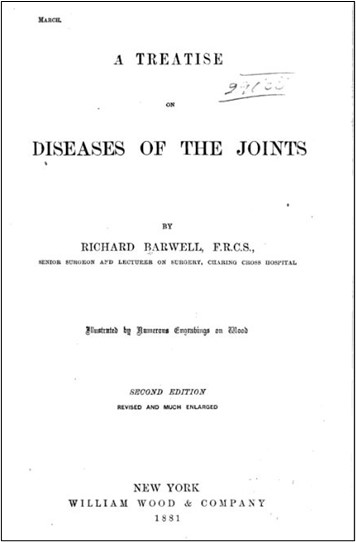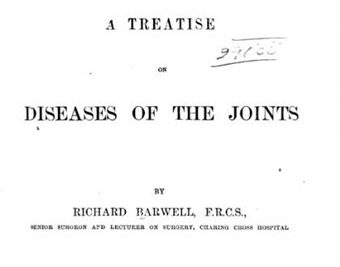A Treatise on Diseases of the Joints (2nd ed) (1881), Richard Barwell MD
By Brett Mattingly

The historical understanding of joints, the diseases that affect them, and the development of orthopedics was detailed by Doctor Richard Barwell (1827-1916) in his work, A Treatise on Diseases of the Joints, originally published in 1881. Barwell was a surgeon at the St. Thomas’s Hospital in London and became a demonstrator as St Thomas’ Hospital medical school [1], a prestigious institution that was one of the oldest hospitals in London [2]. St. Thomas’ was also associated with figures such as William Cheselden (1688-1752), who was instrumental in the establishment of surgery as a scientific medical profession; and Florence Nightingale (1820-1910), renowned nurse, teacher, statistician, and founder of the modern nursing profession. After his time at St. Thomas’, Barwell then became a prominent senior surgeon at Charing Cross Hospital, practicing from 1872-1888. He was also an instructor in comparative anatomy in the Charing Cross medical school from 1856-1874 [3], which highlighted his expertise in orthopedic surgery. During this time, the culture of specialized training in a specific part of the anatomy or a particular disease was just developing. Orthopedic surgery was in its infancy. As an orthopedic surgeon, Barwell had in-depth and extensive knowledge of the anatomy and pathology of the joints as well as the treatment of the diseases that specifically target the joints of the human body. His Treatise on Diseases of the Joints (2nd ed, 1881) was originally written for use and reference by other physicians and medical students in their education and practice. The book provides detailed illustrations of the various components of the joints and the distinctive markers to use as diagnostic criteria and landmarks for the various diseases that specifically affect the joints. Each section concludes with a description of every known treatment of the specific disease being examined, including how to administer each treatment; possible adverse or damaging effects on the diseased and surrounding tissue; possible side effects on the patient; and the success of the treatment.
As both a scientist that specializes in bone biology and researches the diseases that effect the bone and joints, I can honestly say that in order to fully understand a field of study, you need to understand its history. The history of medical education is a fascinating subject and much can be learned about the teaching environment and clinical understanding of the time in texts like Barwell’s Treatise. It can also provide an insight into the mindset of medical educators and allow a unique observer’s lens on medical education as it has evolved.
(This post was written for the course HIST H364/H546 The History of Medicine and Public Health. Instructor: Elizabeth Nelson, School of Liberal Arts, Indiana University, Indianapolis).
References:
[1] “Barwell, Richard, 1827-1916.” Art and Medicine, n.d. Online: http://www.artandmedicine.com/biblio/authors/Barwell.html.
[2] “History of Old St Thomas’ Hospital.” The Old Operating Theater: Museum and Herb Garret, n.d. Online: https://oldoperatingtheatre.com/explore/history-of-old-st-thomas-hospital/.
[3] “Barwell, Richard, 1827-1916.” Art and Medicine, n.d. Online: http://www.artandmedicine.com/biblio/authors/Barwell.html.
